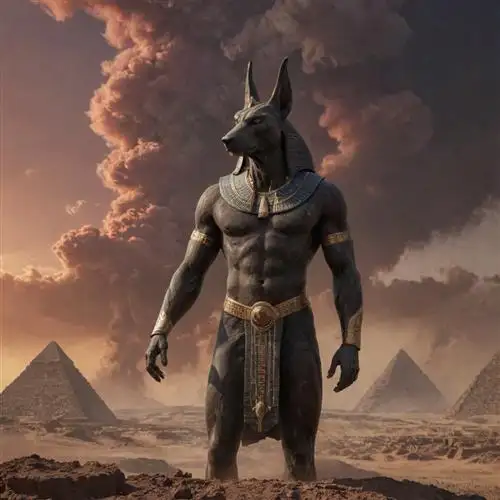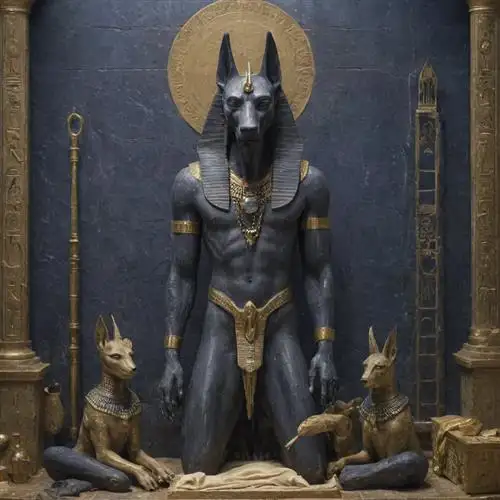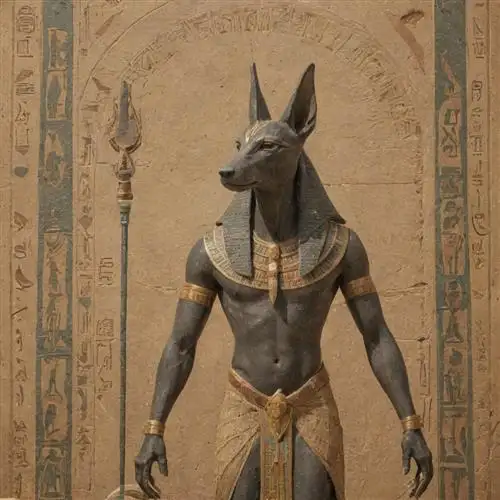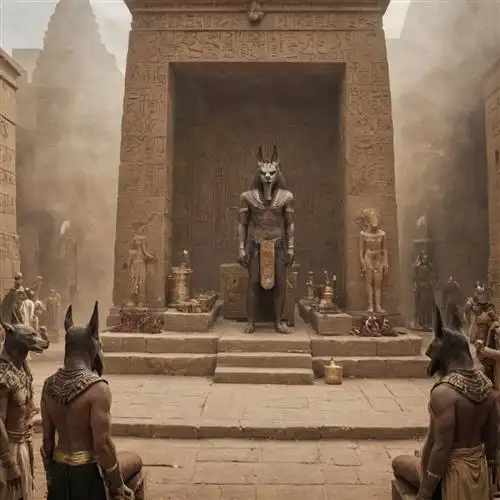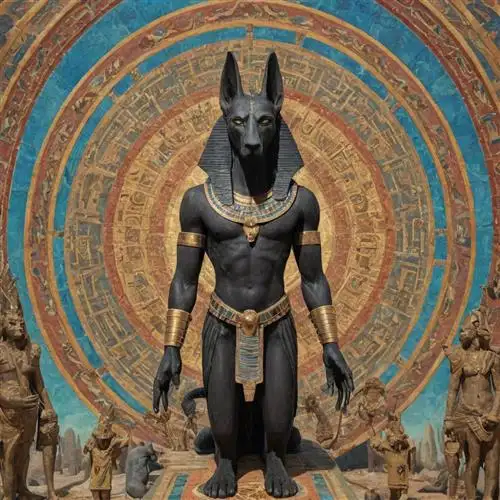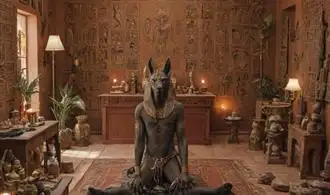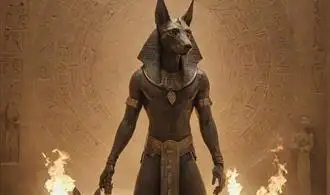
The Origins and Significance of Anubis
Anubis, the jackal-headed god, holds a profound and enduring significance in ancient Egyptian mythology. Believed to be one of the oldest deities in the Egyptian pantheon, Anubis' origins can be traced back to the predynastic period, long before the unification of Upper and Lower Egypt. His association with death and the afterlife has made him a central figure in the complex and intricate funerary rituals of the ancient Egyptians.
The exact origins of Anubis are shrouded in mystery, but scholars believe that he may have been initially worshipped in the region of Cynopolis, a city located in Upper Egypt. The jackal or wild dog was a common sight in the deserts surrounding this area, and it is believed that the ancient Egyptians associated these animals with the transition between the world of the living and the realm of the dead.
Anubis' role as the god of the dead is multifaceted and complex. He is often depicted as the guardian of the necropolis, responsible for the embalming and mummification of the deceased. This crucial role made Anubis an indispensable figure in the ancient Egyptian belief system, as the successful transition of the deceased into the afterlife was paramount to the continuation of life and the preservation of one's identity.
Additionally, Anubis was believed to preside over the "weighing of the heart" ceremony, a crucial step in the ancient Egyptian afterlife journey. During this ritual, the heart of the deceased was weighed against the feather of truth, symbolizing the judgment of the individual's actions and worthiness to enter the afterlife. Anubis' presence as the overseer of this process underscores his significance as the arbiter of the dead, ensuring the proper and just transition of the soul.
The iconography of Anubis further emphasizes his role and symbolism. Typically depicted with the head of a jackal or wild dog, this distinctive feature is believed to be a representation of the animal's keen sense of smell, which was essential in the mummification process. The jackal was also associated with the desert, a domain that was closely linked to the realm of the dead in ancient Egyptian cosmology.
Anubis' prominence in the Egyptian pantheon is further evidenced by his presence in numerous funerary texts and rituals. The Book of the Dead, a collection of spells and incantations designed to guide the deceased through the afterlife, features Anubis prominently, highlighting his indispensable role in the journey of the soul.
The Responsibilities and Roles of Anubis
Anubis, the enigmatic deity of ancient Egyptian mythology, was revered for his multifaceted responsibilities and roles in the afterlife. As the god of the dead, Anubis was responsible for guiding the deceased through the treacherous journey of the underworld, ensuring their safe passage to the afterlife.
One of Anubis's primary roles was to oversee the mummification process. The ancient Egyptians believed that preserving the body was crucial for the soul's successful transition to the afterlife. Anubis, with his jackal-like head, would carefully watch over the mummification rituals, ensuring the proper preparation and preservation of the deceased's physical form.
Another crucial responsibility of Anubis was the weighing of the heart ceremony. This pivotal ritual determined the deceased's worthiness to enter the afterlife. Anubis would place the heart of the deceased on one side of a scale, while the feather of truth, representing moral righteousness, was placed on the other side. If the heart was found to be heavier than the feather, it was devoured by the devouring monster, Ammit, condemning the soul to eternal damnation.
Anubis's role as the gatekeeper of the underworld was also of paramount importance. He would guide the deceased through the gates of the afterlife, ensuring their safe passage to the realm of Osiris, the lord of the dead. Anubis's presence was believed to provide protection and guidance, safeguarding the soul's journey to the next life.
Additionally, Anubis was responsible for the embalming and preservation of the body. He was often depicted as a jackal or a man with a jackal head, reflecting his association with the mummification process. The jackal was chosen as Anubis's animal form due to its scavenging nature, which was believed to be connected to the embalming and preparation of the deceased.
The Iconography and Symbolism of Anubis
Anubis, the ancient Egyptian deity associated with the afterlife, is instantly recognizable by his jackal-headed or canine form. This distinct iconography is laden with profound symbolism that offers insights into the role and significance of this enigmatic figure within the Egyptian pantheon.
The jackal or canine head of Anubis is believed to be a symbolic representation of his connection to the wilderness and the desert regions where these animals thrived. Jackals were often observed near burial sites, scavenging the remains of the dead, which led the Egyptians to associate them with the realm of the afterlife. Anubis, as the god of embalming and funerary rites, was thus closely tied to these creatures and their habitats.
The black color of Anubis' skin is another crucial aspect of his iconography. The black hue is symbolic of the fertile soil of the Nile River valley, which was essential for the regeneration of life. This color also represents the decay and decomposition of the physical body, which was necessary for the rebirth and transformation of the soul in the afterlife.
Anubis is often depicted holding a Was scepter, a symbol of power and dominion, and the Ankh, the hieroglyphic sign for "life." These objects underscore Anubis' role as a guide and protector of the deceased, ensuring their safe passage to the afterlife and their eventual rebirth.
Another common iconographic element associated with Anubis is the canopic jar. These vessels were used to store the internal organs of the deceased during the mummification process, and Anubis was responsible for overseeing this crucial step in the funerary rites. The jackal-headed Anubis is often shown standing guard over the canopic jars, further emphasizing his role as the guardian of the dead.
The Worship and Rituals Honoring Anubis
Anubis, the jackal-headed Egyptian god, held a central role in the ancient Egyptian pantheon as the deity responsible for guiding and protecting the dead. The worship and rituals honoring this powerful figure were an integral part of the Egyptian funerary tradition, with the god's presence permeating every aspect of the journey from death to the afterlife.
At the heart of Anubis' veneration was the embalming process, which the god was believed to oversee. Embalmers, known as "priests of Anubis," meticulously prepared the deceased for their final resting place, ensuring the body was properly mummified and the soul was prepared for the afterlife. This process was seen as a sacred duty, with the embalmers invoking Anubis' protection and guidance throughout the proceedings.
The rituals associated with Anubis were intricate and multifaceted. During the mummification process, the embalmer would invoke the god's name, asking for his assistance in preserving the body and guiding the soul. The jackal-headed figure was often depicted on the sarcophagi, funerary masks, and other burial objects, symbolizing his role as the protector of the dead.
Beyond the embalming ritual, Anubis was also honored through funerary processions and ceremonies. In these events, statues or images of the god would be carried in solemn processions, with priests and mourners offering prayers and offerings to the deity. The god's presence was believed to be essential in ensuring the safe passage of the deceased to the afterlife.
Temples and shrines dedicated to Anubis were found throughout ancient Egypt, with the most significant located in the city of Cynopolis, where the god was worshiped as the primary deity. These sanctuaries served as hubs for the faithful, who would visit to make offerings, seek the god's guidance, and participate in rituals honoring the lord of the dead.
The worship of Anubis was not limited to the elite or the royal class; it was a practice that permeated all levels of ancient Egyptian society. Commoners and nobles alike sought the god's protection and favor, believing that his intervention was crucial in ensuring a successful transition to the afterlife.
The Legacy and Enduring Influence of Anubis
Anubis, the ancient Egyptian god of the dead, has left an indelible mark on human history and culture. His influence extends far beyond the confines of the ancient Nile civilization, resonating through the ages and permeating various aspects of our modern world. Exploring the legacy of this iconic deity unveils a tapestry of profound symbolism, enduring religious practices, and a lasting impact on art, literature, and even popular culture.
At the heart of Anubis' legacy lies his pivotal role in the Egyptian religious and funerary traditions. As the god responsible for the embalming and protection of the dead, Anubis was a central figure in the intricate rituals and beliefs surrounding the afterlife. His jackal-headed image became a powerful symbol of the transition from life to death, guiding the deceased through the perilous journey of the underworld. This profound connection to the realm of the dead has cemented Anubis' status as a timeless icon of mortality and the sacred rites that honor it.
The enduring influence of Anubis can be witnessed in the continued reverence and fascination he garners from scholars, enthusiasts, and the general public alike. His iconic imagery, replete with the distinctive jackal-like features, has become a ubiquitous presence in various forms of art and media. From ancient Egyptian tomb paintings and sculptures to modern-day graphic novels, film, and video games, Anubis continues to captivate audiences, serving as a tangible link to the rich tapestry of ancient Egyptian mythology and belief systems.
Moreover, the legacy of Anubis extends beyond the realms of art and mythology, infiltrating the realms of religious and spiritual practice. Contemporary Pagan and Occult traditions have embraced Anubis as a powerful deity, incorporating his symbolism and attributes into their rituals and belief systems. This ongoing veneration speaks to the enduring relevance of Anubis and his ability to resonate with the human desire to connect with the mysteries of death and the afterlife.
The influence of Anubis is not limited to the realms of art, religion, and spirituality but has also permeated popular culture. The god's iconic image has become a recognizable motif in various forms of entertainment, from television and film to literature and gaming. This widespread cultural appropriation underscores the timeless allure of Anubis and his ability to captivate the imaginations of audiences across the globe, transcending the boundaries of time and space.

